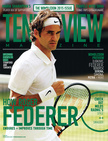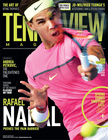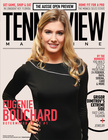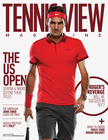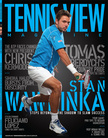Don't miss any stories → Follow Tennis View
FollowMichael Downey Lands in London to Lead the LTA
In December 2013, Tennis Canada President and CEO Michael Downey sold his house, attended his final board meetings, and said his goodbyes at going-away parties. In the midst of his career transition, Downey slipped in a major life milestone by marrying Jinder Chalmers, whom he met on a plane while flying to Vancouver for a Davis Cup event a few years ago. After a jaunt to Jamaica with his new wife and their children, Downey landed in London on December 27, ready to take the reins of British tennis.

As new chief executive of Great Britain’s Lawn Tennis Association (LTA), Downey will bring a strong reputation for increasing tennis participation and developing funding to an organization looking to improve the depth of British tennis while making the most of two-time major champion Andy Murray’s success.
Top-ranked Canadian man Milos Raonic, who reached a career-high ranking of No.10 in 2013, described Downey’s enthusiasm for tennis: “He wouldn't sit in the courtside seats [at Davis Cup],” said Raonic. “He'd be up in the crowd with the Canadian fans. You could hear his voice above everybody else’s. He gets very involved emotionally because he wants you to do well. He's not just doing his job as a businessman. He really cares about the players and has a very good relationship with them.”
In an exclusive interview with Tennis View, Downey spoke about his decision to take on the challenge of leading the LTA as well as his time at Tennis Canada.
Q: Where in London will you be living?
Michael Downey: We’re renting a three bedroom house in St. Margarets, across the river from Richmond, which is very close to the National Training Center. It’s a really nice place and we love nature; it’s got a creek at the bottom of our backyard and ducks and everything else. We just love all the green space all around Richmond.
Q: Are you ready for the rainy weather?
Downey: I probably am not. My wife is. She’s from Vancouver, so she’s used to rainy weather. But when I was over here for the ATP World Tour Finals, we bought a raincoat for me, so at least I’m ready when I land.
Q: What did the hiring process entail for the LTA?
Downey: I was lucky enough to spend a fair bit of time with David Gregson, who is going to be my Chairman. It was a great way of him interviewing me, but also me understanding where he was coming from because there’s no doubt the CEO and the chairman in any organization need to have a great partnership. The formal interview process happened in London in September. I met with five or six people who sat on the committee, and I was able to have dinner with a board member. That time I spent with David made it very clear to me that this is a job I wanted because I felt that we could work very closely together and have a good partnership.
Q: What factors did you consider when deciding to take this position?
Downey: There’s a rich history of this sport in Britain. I was fully aware of the historical prestige of the LTA and looked at that as a once-in-a-lifetime opportunity after running [Tennis Canada] for nearly ten years. And I looked at myself at nearly 56 years of age and said, what a grand opportunity to go and live in London to lead that storied organization, and at the same time be able to experience an altogether new culture and be so close to the rest of Europe. I’m pinching myself that I have this opportunity. I’m also pinching myself that the LTA would look across the ocean to hockey-mad Canada to find its next CEO. I think it reflects so favorably on this organization and the stature of tennis in Canada.
Q: Have you started to assess your priorities for what you want to address first when you take over in January?
Downey: It’s a good question, and I really haven’t spent a lot of time on it. Partly because I wanted to make sure I closed down my tenure at Tennis Canada with excellence, so I really tried to finish a lot of projects that I started, like contracts with Milos Raonic and Eugenie Bouchard. I believed you’re remembered by how you left and not just what you did. So I really focused on trying to leave with a sense of pride that the organization’s in good shape.

Q: You’re credited with improving grassroots tennis participation in Canada. How can a country take advantage of a top player’s success, like Andy Murray’s Wimbledon victory?
Downey: We feel that especially Milos Raonic’s success has made a difference here in Canada. Davis Cup is a prime example. I think that even Milos is surprised by how much getting to the Davis Cup semifinals drove tennis in this country. He was on the front page of our national newspapers in February and April, and that’s the heart of the hockey season. It shows that Canadian pride can be delivered with tennis, and Milos and the rest of the team delivered with Davis Cup.
Q: Raonic told reporters that he can hear you cheering at Davis Cup because your voice stands out in the crowd.
Downey: I have certain things I yell, and Milos or [Aleksandra] Wozniak or Eugenie Bouchard, they would know it’s me because of certain things I’m yelling.
Q: What were you yelling?
Downey: There’s a funny story with [Wozniak]. She’s French-Canadian, and I used to yell, “Bring on the swagger!” and she’d come up to me after a couple of times and said, “What does swagger mean again?” But she knew it was me! I quite enjoy doing that, and I think it makes a difference.
Q: What are you most proud of when you reflect on your time at Tennis Canada?
Downey: What I’m most proud of is how the culture of this organization has changed under my leadership and under the leadership of the board. Tennis Canada has a great family culture, and it’s a great place to work. This organization has a great history with two phenomenal tournaments in Toronto and Montreal. I brought in, and the board approved, a pay-for-performance bonus that in its own right has really helped establish that it isn’t good enough to try. We have to succeed. We’ve done that by raising a lot more money and investing it behind a solid strategic plan.
I really believe that everything is driven by strategy. When I joined, we were spending maybe $3-3.5 million in tennis development, and in 2013 we spent $12 million. Financially we’ve been really strong and invested wisely, especially in high performance. That’s what I’m most proud about. It all starts with culture, and we have more of an orientation towards results. Success breeds success.


